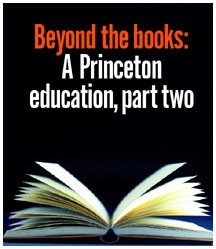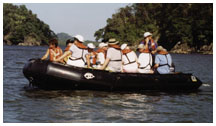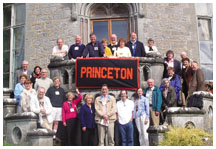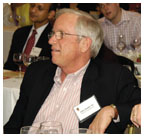
|
|
November 2, 2005: Features
 Sure,
alumni education means lectures – but don’t forget the wine
tasting or snorkeling
Sure,
alumni education means lectures – but don’t forget the wine
tasting or snorkeling
By Brett Tomlinson
(IMAGE:
Stockbyte)
When Princeton’s Alumni College seminars began reaching out to tap graduates’ intellectual curiosity in the early 1970s, the topics of study were broad and weighty — race in America, the future of the environment, and the history of revolutions, to name a few. Even as the program branched out to tourist locales, such as Martha’s Vineyard, the focus remained on the classroom experience, with four or five days of lectures by Princeton faculty. There was no time for exploring the field, and, as ecology and evolutionary biology professor James Gould recalls, “not a lot of time for walking on the beach.”
Today, the focus of Princeton’s travel program, now known as Princeton Journeys, is on learning by doing: studying biological diversity in the Amazon Basin or — before Hurricane Katrina — delving into the roots of jazz in the heart of New Orleans. Gould, who led a 2004 trip to the reefs and rainforests of Belize, Guatemala, and Honduras, recalls snorkeling through remarkable reefs near a small island off the coast of Belize on the first day of the trip. The next day, after Gould gave a lecture about coral, the group asked to return to the reefs and the tour operators obliged, sending out the Zodiac landing crafts for another day of exploration.
“There’s a great deal more emphasis on getting out and doing,” Gould says of the Journeys trips. “Yes, lectures are fine, but even more important is to go out and see it. Walk up to it. Argue about what it is. Get wet, get dirty, get tired. I think that’s terrific.”
On a January 2004 trip to Belize, Guatemala, and Honduras, Professor James Gould and participants in Princeton’s alumni travel program, Princeton Journeys, explored coral reefs, coastal rivers, and – on land – Mayan ruins. (Courtesy James Gould)
In July 2004, professors Paul Muldoon and Michael Cadden led Princeton Journeys participants, pictured here at Markree Castle, on a literary tour of Ireland. Front, from left: William Ledger ’54, Jacquie Ledger s’54, Betsy Miller s’55, Dan Miller ’55, Eileen Rettig s’65, Ken Rettig ’65, Frank Pindyck ’62, Carol Sellery s’60, Suzanne Pindyck s’62, Dave Bruton ’57, Jim Dinneen ’84, Mary Lhevine s’60, George Schnetzer ’60, Judith Golden s*54, Peggy Bruton s’57, Hella McVay s’55, and Scott McVay ’55. Back, from left: Michael Cadden, Bob Sellery ’60, John Ives ’61, Geri Amori s’61, Dick Golden *54, Rosemary Selinger s’65, Sam Selinger ’65, Liz Morgan s’46, Paul Muldoon, and Perry Morgan ’46. (courtesy Princeton Journeys)
Professor Jenna
Weissman Joselit’s online alumni course, “Let’s
Eat,” brought together about 60 New York-area alumni, including
John Zoeller *67, above, for a wine tasting at the Princeton Club
of New York last May. |
The University is hoping that alumni will feel the same way. Travel is the largest portion of a wider effort by Princeton to build connections with alumni through intellectual programs; in recent years, the Alumni Council has increased its travel staff and created new programs intended to appeal to younger alumni who might not have the time or the money to take part in a lengthy excursion that costs several thousands of dollars, as some trips do. At the same time, new four- to six-week Alumni Studies courses available on the Web are aimed to appeal to busy professionals and tech-savvy retirees. And in September, the Alumni Council introduced Tiger Tomes, an online book club where alumni can read and discuss the work of Princeton authors.
“We have 79,500 alumni, but they range in age from 22 to 100-plus, so they have very different wants and needs,” says Margaret Miller ’80, director of the Alumni Council. “Our mission is to reach as many alumni as we can in as many different ways as we can.”
Princeton was something of a latecomer to alumni travel; peer institutions have been providing trips and tours for alumni for decades, in some cases on a grand scale. Harvard and Stanford, whose alumni bodies include graduates of several professional schools, offer as many as 50 trips per year. But until recently, Princeton’s alumni travel program featured only three or four options annually.
In 2000, the Alumni Council began discussing expanding the program and, after evaluating other alumni travel programs as well as the demand among Princeton alumni, it decided to grow to a maximum of 20 trips per year by 2008 (there are 15 trips on the 2006 schedule). The staff grew as the program expanded. Of the alumni education program’s five staff members, three work full time with Princeton Journeys.
Providing a rich educational experience was at the heart of the Princeton Journeys plan, says Andrew Gossen ’93, associate director for alumni education. The trips have study leaders who are either Princeton faculty or alumni with expertise in the topics that the travelers explore. Princeton Journeys trips were also designed to foster camaraderie, with group meals and group photographs, complete with the Princeton banner, on every trip. So far the travel program has met expectations. Of the 30 trips offered, only two were canceled for lack of interest, and several have added additional departures to accommodate more people. About half of the trips are custom-designed for Princeton; the others are existing tours that are tailored to fit the goals of the study leaders.
The study leaders appreciate the inquisitiveness of the travelers. Catherine Burns Scallen *90, an art history professor at Case Western Reserve University, led a Princeton Journeys trip to the Netherlands and Belgium last spring, lecturing about Dutch art as the group traveled from museum to museum on the region’s picturesque waterways. Though few of the travelers had extensive knowledge of Dutch art, Scallen says, they had a sophisticated understanding of the arts in general and asked provocative questions.
Tour operators like alumni groups because they usually provide an instant queue of interested participants and a knowledgeable study leader to guide the group. Nancy Collins ’91, the president of Global Adrenaline, a tour operator that specializes in trips to South America, Africa, and New Zealand, says that alumni travelers also tend to favor local culture over tourist traps. “They don’t want a sanitized view of a country,” she says. “They want to see how people really live.”
Still, travel requires time and money, making it difficult for young alumni and alumni with children to participate. Most of the trips cost between $3,500 and $7,000 per person and last 10 to 14 days. That range is widening, on both ends. While an upcoming “World Leaders Symposium” trip, a 12-day Baltic Sea cruise with a panel of speakers scheduled to include Mikhail Gorbachev and Lech Walesa, starts at nearly $10,000, a six-day tour of important sites of the civil rights movement in Alabama costs just over $2,000 per person. (“In some cases, the shorter programs are the most academically demanding of our travels,” the program brochure cautions.) Moderately priced options designed to target specific audiences, including a family trip to Costa Rica and a young alumni trek to Machu Picchu in 2005 [see story on page 24], have helped to draw some alumni from the more recent classes into Princeton Journeys, and the program has pumped up its marketing efforts, with a full-color catalog and a monthly e-mail newsletter.
At the same time, Princeton’s on-campus alumni education programs remain among the most popular alumni attractions. Alumni Day drew 1,200 alumni and friends last February, and more than 2,300 Reunions visitors attended the Alumni-Faculty Forums in May. The Alumni Council sponsors morning lectures during the fall on the weekends of home football games, when many alumni return to campus, as well as a series of lectures in the spring. Off-campus, the University reaches out to regional alumni groups through visits by faculty members, who typically speak about their research and teaching. Princeton faculty made about 60 visits to alumni groups in 2004–05, Miller says.
In the last decade, technology has enabled universities to add offerings for alumni looking to plug into the intellectual side of campus life, particularly through Internet applications, which have opened intriguing but imperfect opportunities. In 2000, Princeton, like some of its peers, explored offering online courses to its alumni through the Alliance for Lifelong Learning, which also included Stanford, Oxford, and Yale. A year later, as the Alliance steered toward a for-profit business model, Princeton pulled out of the group, deciding instead to create its own online content under the name @Princeton Courseware.
The Courseware offerings began as 12-week, in-depth classes led by prominent faculty members such as Paul Muldoon, John Nash *50, and Anthony Grafton. Though alumni signed up for the courses, few finished the full 12 weeks. According to Ann Kirschner *78, a member of Princeton’s Committee on Academic Programs for Alumni (CAPA) and the former president of Fathom, Columbia University’s online learning initiative, long courses simply do not fit into the busy schedules of most alumni. “People vote with their feet,” Kirschner says, “or in this case, with their fingers, tapping on a keyboard.”
Last spring, Princeton offered an online alumni course called “Let’s Eat,” an adaptation of history professor Jenna Weissman Joselit’s freshman seminar on the role of food in contemporary American culture. The six-week course cost $50, and more than 100 households signed up, 30 percent of which were from the Class of 2000 or later. Gossen said the younger classes added a burst of energy to the online class discussions, keeping most of the audience engaged for the entire length of the course.
Based on the success of “Let’s Eat,” the University is setting up similar courses in 2005–06, according to Gossen. Over the summer, he also designed and refined the message-board format for Tiger Tomes, which kicked off in September with an exploration of Ian Caldwell ’98 and Dustin Thomason’s The Rule of Four. In the book club, Gossen wants to combine educational content with the successful discussion group setting that has engaged thousands of alumni on TigerNet, the University’s online alumni community. (Last year, alumni in TigerNet groups posted 37,000 messages.)
Alumni education can be a way to connect with those who might not otherwise engage in Princeton activities, says Robert Varrin ’56 *57, chairman of CAPA. Varrin is the type of alumnus who audits courses, rarely misses a home football game, and wears his Princeton ring on his left hand, one finger away from his wedding band. But he realizes that for some alumni, including those from the Graduate School, the connection to Princeton is more academic. “I think it’s easier to get them to identify back to the University through education than it is through P-rades,” he says.
Bob McCartney ’56, a veteran of 11 Alumni Colleges and Princeton
Journeys trips, notes another incentive, particularly for alumni travel:
a common bond. Says McCartney, “The Princeton connection is simply
the world’s best ice-breaker.” ![]()
Brett Tomlinson is an associate editor at PAW.



